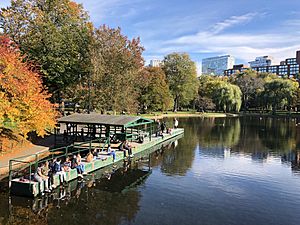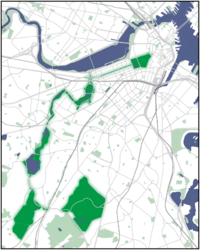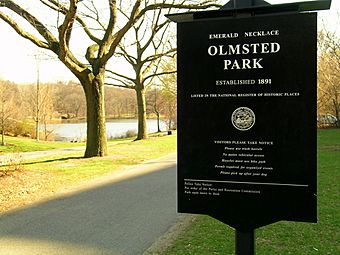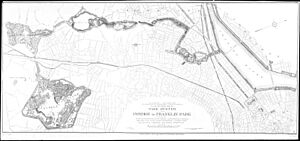Emerald Necklace facts for kids
Quick facts for kids Emerald Necklace |
|
|---|---|

Boston Public Garden, the second "jewel" of the Emerald Necklace
|
|
 |
|
| Type | Park system |
| Location | Boston and Brookline, Massachusetts, United States |
| Created | 1860s |
| Designer | Frederick Law Olmsted |
| Operated by | Emerald Necklace Conservancy |
| Open | All year |
|
Olmsted Park System
|
|
 |
|
| Built | 1870 |
| NRHP reference No. | 71000086 |
| Added to NRHP | December 8, 1971 |
The Emerald Necklace is a special group of parks in Boston and Brookline, Massachusetts. It's like a long chain of green spaces, about 1,100 acres big, connected by roads and rivers. A famous landscape architect named Frederick Law Olmsted designed it. It got its name because it looks like a necklace hanging around the "neck" of the Boston area on a map. In 1989, this park system was named a Boston Landmark, which means it's a very important historical place for the city.
Contents
Exploring the Emerald Necklace Parks
This amazing park system makes up half of all the parkland in Boston. It also includes parks in the town of Brookline and special roads managed by the state of Massachusetts. More than 300,000 people live near these parks. You can walk or bike about seven miles through the parks, starting from Boston Common and going all the way to Franklin Park.
The Emerald Necklace includes many different green spaces:
- Boston Common
- Public Garden
- Commonwealth Avenue Mall
- The Fens
- Forsyth Park
- The Riverway
- Olmsted Park
- Jamaica Pond
- Jamaicaway
- Arborway
- Arnold Arboretum
- Franklin Park
Some parts of the Emerald Necklace were already there before the whole plan to connect them. These parks are not just fun places to visit. They are also important for nature, providing homes for migratory birds and helping to keep the city's air quality clean.
History of the Emerald Necklace
The idea for these connected parks came from Frederick Law Olmsted. He wanted to link older parks like Boston Common (from colonial times) and the Public Garden (created in 1837) to a larger area called Franklin Park. Franklin Park was known as the "great country park."
The project started around 1878. The first step was to clean up a swampy area that became the Back Bay and The Fens. In 1880, Olmsted suggested including the Muddy River in the park plan. This river flowed from Jamaica Pond through the Fens. Workers dug out the river to make it wind naturally and directed it into the Charles River. The land around the river became the long park you see today. Olmsted's dream of a park with walking paths, a gentle stream, and small ponds was finished by the early 1900s. The parks Olmsted designed, from Storrow Drive south to Franklin Park, are listed together as the Olmsted Park System. This means they are recognized as important historical places.
Over the last ten years, about $60 million has been spent to improve the parks and waterways in the Emerald Necklace. These improvements included better paths, new plants, signs, bridge repairs, and fixing up boardwalks and buildings. Some areas, especially the wooded parts of Franklin Park and Olmsted Park, needed a lot of work after many years of not being cared for.
Many groups, like the Emerald Necklace Conservancy and the Franklin Park Coalition, work hard to protect and improve these parks. They raise money, organize volunteers, and make sure the parks stay beautiful for everyone.
How the Emerald Necklace is Shaped
The Emerald Necklace starts near Boston's Downtown Crossing. It then follows the border between Boston and Brookline. After that, it curves into Jamaica Plain. The part farthest from its start is in Roslindale, near the Arnold Arboretum. From there, it loops back up into Roxbury and Dorchester.
Olmsted's first idea was for the necklace to be shaped like a "U" and end at Boston Harbor. However, the last part, called the Dorchesterway, was never built.
Who Manages the Parks?
Different groups are in charge of different parts of the Emerald Necklace:
- The Arnold Arboretum is managed by Harvard University.
- The western sides of Olmsted Park and the Riverway are managed by Brookline Parks & Open Space.
- Most of the Emerald Necklace is cared for by Boston Parks and Recreation. A smaller part is managed by the Massachusetts Department of Conservation and Recreation.
Emerald Necklace Conservancy: Park Stewards
The Emerald Necklace Conservancy is a non-profit group started in 1998. Their main goal is to make the Emerald Necklace better for everyone. They work with other groups to protect, maintain, and restore the 1,100 acres of parkland. They also help educate people about the parks and encourage volunteers to get involved.
The Conservancy offers many things for visitors. These include events, guided tours, and ways to volunteer. They help people learn about and enjoy the Emerald Necklace.
Protecting the Parks for the Future
The Emerald Necklace Parks Master Plan was created in 1989 and updated in 2001. This plan guides how the parks are cared for.
The parks have often had problems with flooding from the Muddy River. The Muddy River Restoration Project has been working to clean up the river and improve its flow. This helps prevent flooding and makes the river look better. This project started in 2009.
Another challenge for the parks is dealing with Phragmites, which is a type of tall grass that grows too much. This grass is an invasive species, meaning it's not native and can take over. It makes it harder to keep the parks looking the way Olmsted imagined. Many efforts are ongoing to control this plant.
See Also
- Charles River Esplanade
- Columbia Road
- Forest Hills Cemetery
- Larz Anderson Park
- Massachusetts Audubon Society
- Southwest Corridor Park
- Rose Kennedy Greenway
Images for kids





